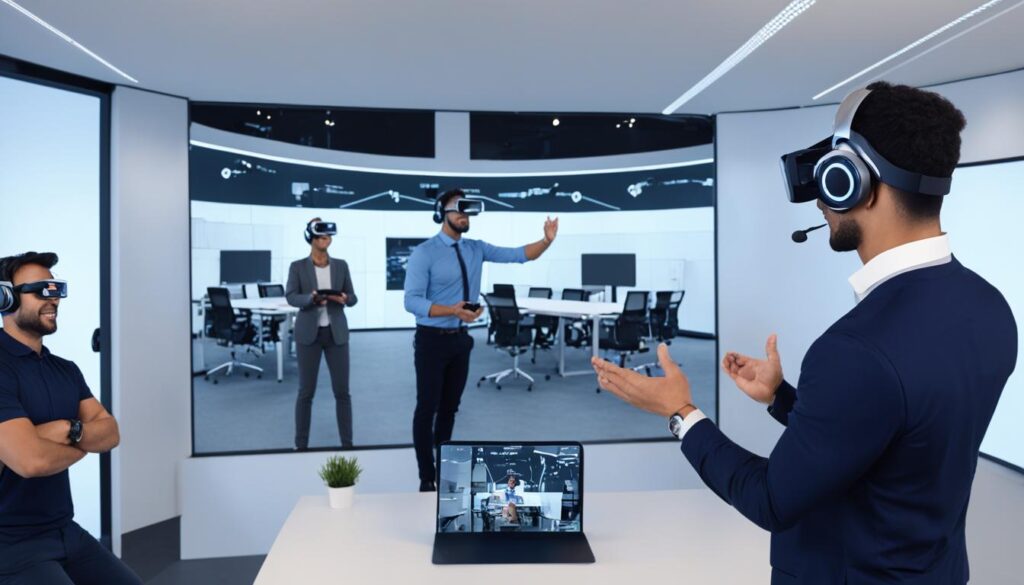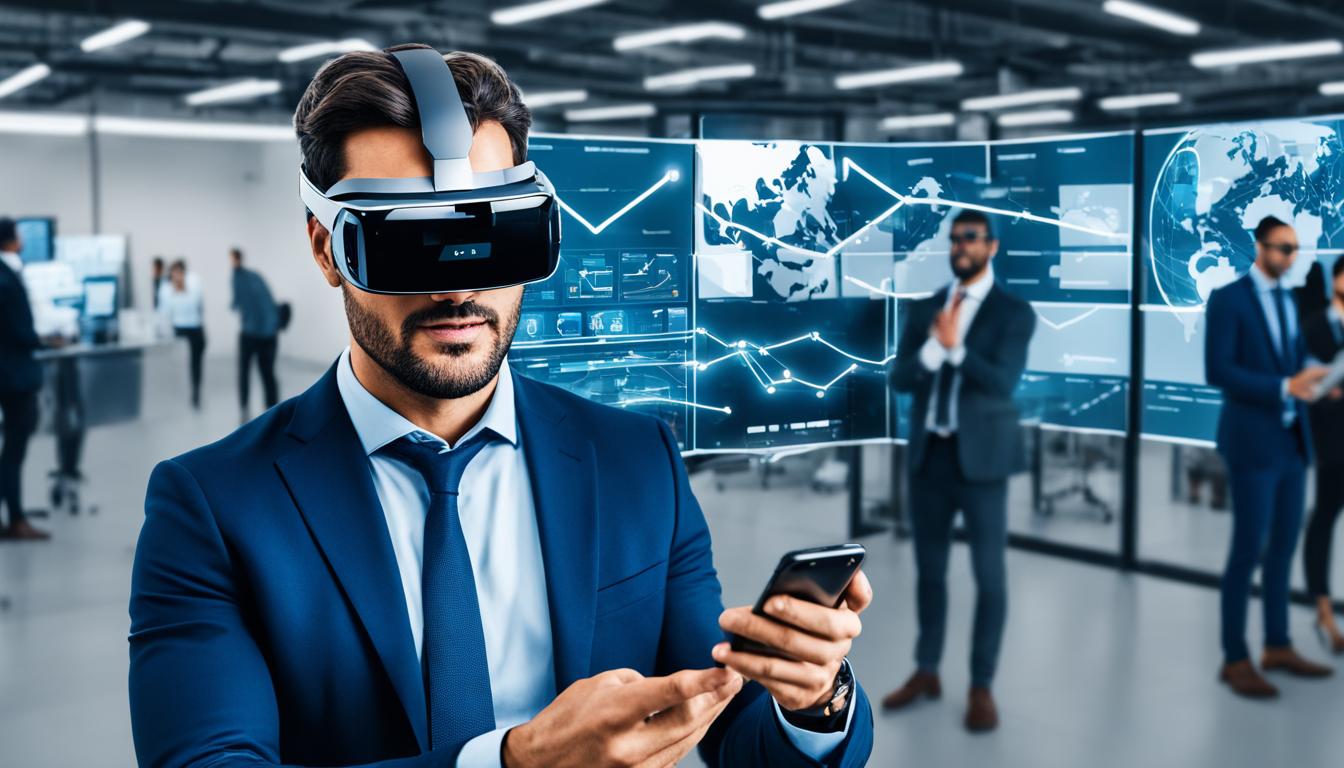Augmented Reality (AR) technology has revolutionized how brands approach marketing and other aspects of their business. By harnessing the power of AR, businesses can create immersive and personalized experiences for their customers, resulting in increased engagement and satisfaction. The benefits of augmented reality in business are numerous, leading to successful implementations across various industries.
With the use of augmented reality, businesses can enhance their marketing strategies to drive customer engagement and boost sales. Retailers and e-commerce brands can leverage AR to create interactive experiences, such as virtual product visualizations and virtual try-on features. This dynamic approach captivates customers and enhances their shopping experience, ultimately leading to increased conversions.
Furthermore, augmented reality is not limited to marketing alone. Businesses are also utilizing AR in employee training programs, enabling immersive and interactive learning experiences. AR training enhances learning retention and skills development, ultimately improving employee performance and productivity.
The manufacturing industry is another sector that benefits greatly from augmented reality technology. By overlaying virtual information onto physical spaces, AR can assist workers in assembly, maintenance, and repair tasks. This results in improved operational efficiency, reduced errors, and increased productivity.
As technology advances, the adoption of augmented reality by businesses is only projected to increase. The future of AR in business holds great potential, with applications across healthcare, travel, entertainment, and more. Although challenges exist, businesses that embrace and incorporate augmented reality in their strategies are well-positioned for success in today’s ever-evolving market.
Contents
- 1 Augmented Reality in Marketing Strategies
- 2 Augmented Reality Training for Employees
- 3 Augmented Reality in Manufacturing and Operations
- 4 The Future of Augmented Reality in Business
- 5 Conclusion
- 6 FAQ
- 6.1 How are businesses using augmented reality technology?
- 6.2 What are the benefits of augmented reality in business?
- 6.3 How is augmented reality being used in marketing strategies?
- 6.4 How is augmented reality employed in the retail industry?
- 6.5 How is augmented reality revolutionizing employee training?
- 6.6 How are businesses adopting augmented reality technology in operations?
- 6.7 What are some successful implementations of augmented reality in business?
- 6.8 What is the future of augmented reality in business?
- 6.9 How is augmented reality changing the way businesses interact with customers?
- 6.10 How can augmented reality training benefit businesses and their workforce?
- 7 Source Links
Key Takeaways:
- Augmented reality is transforming how businesses engage with their customers, resulting in increased satisfaction and loyalty.
- AR is a powerful marketing tool, allowing brands to create interactive and immersive experiences that drive customer engagement and boost sales.
- Businesses can leverage AR in employee training programs to enhance learning retention and skills development, improving employee performance.
- Augmented reality technology is revolutionizing the manufacturing industry, increasing operational efficiency and productivity.
- The adoption of augmented reality by businesses is expected to rise, leading to future applications in various industries.
Augmented Reality in Marketing Strategies
Augmented reality (AR) has become a game-changer for marketing strategies in the retail industry and e-commerce. Brands have recognized the power of AR in creating interactive and engaging experiences for customers, leading to increased customer engagement, satisfaction, and ultimately, higher sales.
With AR, brands can go beyond traditional marketing techniques and offer customers innovative ways to interact with their products or services. Virtual product visualizations, interactive ads, and virtual try-on experiences are just a few examples of how AR is transforming marketing strategies.
Virtual Product Visualizations
AR enables customers to visualize products in a virtual environment, allowing them to see how a particular item would look or fit in their own space. For example, furniture retailers can use AR to let customers virtually place furniture pieces in their homes, giving them a realistic understanding of how it would look in their space.
Interactive Ads
AR ads provide a highly engaging and interactive experience for customers. Brands can create AR-powered advertisements that allow customers to interact with products, view additional information or offers, and even make purchases directly from the ad. This level of interactivity captures customer attention and increases the likelihood of conversions.
Virtual Try-On Experiences
In the fashion and beauty industry, AR allows customers to virtually try on clothing, accessories, and makeup products without having to visit a physical store. By utilizing AR technology, customers can see how different products would look on them, helping them make informed purchase decisions and reducing the chances of returns.
“Augmented reality has revolutionized our marketing campaigns. It has taken our customer engagement to new heights and has significantly boosted our sales. The ability to offer interactive experiences and virtual try-on options has transformed the way our customers shop, resulting in higher customer satisfaction and loyalty.”
https://www.youtube.com/watch?v=rgKBuOh15Fs
| Benefits of Augmented Reality in Marketing Strategies |
|---|
| Enhanced customer engagement through interactive experiences |
| Increased brand visibility and awareness |
| Improved customer satisfaction and loyalty |
| Reduced product returns by allowing virtual try-on experiences |
| Higher conversion rates and sales |
Augmented reality in marketing strategies has proven to be highly effective in the retail industry and e-commerce. By leveraging AR technology, brands can provide memorable and personalized experiences that drive customer engagement, increase sales, and foster long-term customer loyalty.
Augmented Reality Training for Employees
Augmented reality (AR) is revolutionizing the way businesses train and develop their employees. By leveraging AR technology, companies can provide immersive and interactive training experiences that enhance learning retention and skills development. This section will explore successful implementations of AR training in various industries and highlight the benefits it brings to businesses and their workforce.
One of the key advantages of augmented reality training is its ability to create a realistic and engaging learning environment. Employees can interact with virtual objects and scenarios, gaining hands-on experience without the need for physical resources or on-the-job training. This not only improves learning efficiency but also reduces costs associated with traditional training methods.
AR training is particularly effective in industries that require complex tasks or specialized skills. For example, in the healthcare sector, medical professionals can practice surgical procedures in a virtual operating room, allowing them to refine their techniques in a risk-free environment. Similarly, in the manufacturing industry, technicians can simulate equipment maintenance procedures, ensuring they are well-prepared to handle real-world scenarios.

Furthermore, augmented reality training can be tailored to individual learning needs and preferences. Employees can progress at their own pace, revisit areas of difficulty, and receive personalized feedback. This adaptable approach maximizes learning outcomes and ensures that employees acquire the necessary skills and knowledge effectively.
“AR training has transformed the way we onboard new employees. The immersive experiences enable them to quickly grasp complex concepts and gain practical skills without the need for extensive hands-on guidance.”
As businesses continue to embrace the adoption of augmented reality, the benefits of AR training for employees are becoming evident. Improved knowledge retention, enhanced skills development, and cost savings are just some of the advantages that businesses can gain. In addition, AR training promotes employee engagement and satisfaction, leading to higher productivity and reduced turnover.
Successful Implementations of AR Training
| Industry | Company | AR Training Program | Benefits |
|---|---|---|---|
| Retail | ABC Retail | Virtual store walkthroughs for sales associates | – Improved product knowledge and customer assistance – Reduced training time |
| Automotive | XYZ Motors | Virtual car assembly simulations for technicians | – Enhanced understanding of assembly processes – Reduced errors and improved efficiency |
| Education | 123 School District | Virtual science experiments for students | – Increased student engagement and understanding – Access to experiments not feasible in a traditional classroom |
These examples highlight the diverse applications of AR training across industries. Whether it’s improving sales techniques, refining technical skills, or enhancing educational experiences, augmented reality is proving to be a valuable tool for employee training and development.
Augmented Reality in Manufacturing and Operations
Augmented reality is revolutionizing the manufacturing industry by improving operations and efficiency. By overlaying virtual information onto physical spaces, AR can assist workers in assembly, maintenance, and repair tasks.
Enhancing Assembly Processes
With augmented reality, manufacturers can optimize assembly processes by providing real-time visual instructions and guidance to workers. AR overlays virtual components and step-by-step instructions onto physical objects, enabling workers to easily identify parts and follow precise assembly sequences. This streamlines the assembly process, reduces errors, and increases productivity.
Streamlining Maintenance and Repair Tasks
AR technology is also being used to streamline maintenance and repair tasks in the manufacturing industry. By using AR-enabled devices, technicians can access digital overlays that provide real-time information on equipment status, troubleshooting steps, and repair procedures. This enhances efficiency, reduces downtime, and improves the overall maintenance process.
“Augmented reality has transformed how our technicians perform maintenance tasks. The ability to access real-time information and instructions directly through AR headsets has significantly improved efficiency and reduced the learning curve for new hires.”
Increasing Safety and Training
Augmented reality is also utilized in training programs to enhance worker safety and skill development. Employees can use AR to simulate hazardous scenarios and practice safety protocols in a controlled environment. Additionally, AR can provide real-time feedback and guidance during training, improving learning outcomes and reducing the risk of accidents on the manufacturing floor.
<!–
| Benefits of Augmented Reality in Manufacturing and Operations | Productivity | Efficiency | Quality | Cost-effectiveness |
|---|---|---|---|---|
| Improved assembly processes | ✔️ | ✔️ | ✔️ | ✔️ |
| Streamlined maintenance and repair tasks | ✔️ | ✔️ | ✔️ | ✔️ |
| Enhanced worker safety | ✔️ | ✔️ | ✔️ | ✔️ |
–>
By integrating augmented reality in manufacturing and operations, businesses can achieve significant benefits such as improved productivity, enhanced efficiency, higher quality output, and cost-effectiveness. As AR technology advances, we can expect to see further integration of this transformative technology in the manufacturing sector.
<!– –>
–>
The Future of Augmented Reality in Business
As technology continues to advance and become more accessible, the adoption of augmented reality by businesses is expected to increase. The potential applications of AR in various industries, including healthcare, travel, and entertainment, are vast and promising.
One of the key benefits of integrating augmented reality into business strategies is the enhanced customer experience. AR allows customers to interact with products and services in a more immersive and personalized way, leading to increased engagement, customer satisfaction, and ultimately, sales.
For example, in the healthcare industry, augmented reality can be used to visualize medical procedures and educate patients about their conditions. This technology can provide a better understanding of complex concepts, leading to more informed healthcare decisions.
In the travel industry, augmented reality can enhance the tourism experience by providing virtual guided tours, interactive maps, and real-time information about landmarks and attractions. This allows travelers to explore destinations in a more engaging and informative manner.
Challenges and Considerations
While the future of augmented reality in business holds immense potential, there are challenges and considerations that need to be addressed. One of the main challenges is the cost of implementing AR technology, including the development of customized applications and devices.
Additionally, businesses need to ensure that they have the necessary infrastructure and technical expertise to support augmented reality implementations. This may require investments in hardware, software, and IT support.
Data privacy and security are also critical considerations when adopting augmented reality in business. As AR relies on collecting and analyzing user data, businesses must prioritize protecting customer information and complying with privacy regulations.
Conclusion
In conclusion, augmented reality technology has completely transformed the business landscape, revolutionizing customer interactions, employee training, and operational efficiency. Businesses across various industries are leveraging the power of augmented reality to create immersive and personalized experiences for their customers.
The applications of augmented reality in business are vast and diverse. From marketing and retail to training programs and manufacturing operations, businesses are finding innovative ways to implement augmented reality and reap its benefits. Augmented reality in business applications allows brands to engage customers on a whole new level, resulting in increased customer satisfaction and improved sales.
Moreover, augmented reality technology also plays a crucial role in employee training and development. By providing immersive and interactive training experiences, businesses are equipping their workforce with the necessary skills and knowledge to excel in their roles. The adoption of augmented reality in training programs has proven to enhance learning retention and improve overall performance.
As augmented reality technology continues to evolve and become more accessible, businesses that embrace its potential are at a significant advantage. Augmented reality is here to stay, and companies that harness its power will continue to thrive in the future. With its ability to create engaging and personalized experiences for customers, enhance employee training, and improve operational efficiency, augmented reality has become an indispensable tool for businesses across industries.
FAQ
How are businesses using augmented reality technology?
Businesses are using augmented reality technology in various ways, including in marketing strategies to create immersive and engaging experiences for customers, in employee training programs to provide interactive learning experiences, and in the manufacturing industry to assist workers in assembly and maintenance tasks.
What are the benefits of augmented reality in business?
Augmented reality in business offers several benefits, including increased customer engagement and satisfaction, enhanced employee training and skills development, improved operational efficiency, and the ability to create personalized and immersive experiences for customers.
How is augmented reality being used in marketing strategies?
Augmented reality is being used in marketing strategies to create interactive and engaging experiences for customers. Brands can use AR to provide virtual product visualizations, interactive ads, and virtual try-on experiences, among other applications, to enhance customer engagement and drive sales.
How is augmented reality employed in the retail industry?
In the retail industry, augmented reality is used to enhance the shopping experience for customers. Brands can use AR to offer virtual fitting rooms, allow customers to virtually try on products, and provide virtual product visualizations, which helps customers make informed purchasing decisions and increases customer satisfaction.
How is augmented reality revolutionizing employee training?
Augmented reality is revolutionizing employee training by providing immersive and interactive learning experiences. Businesses can use AR to simulate real-life scenarios, enabling employees to practice and develop their skills in a safe and controlled virtual environment. AR training improves learning retention and helps employees acquire the necessary knowledge and skills more effectively.
How are businesses adopting augmented reality technology in operations?
Businesses in the manufacturing industry are adopting augmented reality technology to improve operations and efficiency. By overlaying virtual information onto physical spaces, AR can assist workers in assembly, maintenance, and repair tasks, reducing errors and increasing productivity.
What are some successful implementations of augmented reality in business?
Successful implementations of augmented reality in business include using AR in marketing strategies to create engaging experiences, employing AR in employee training programs to enhance learning retention, and integrating AR in the manufacturing industry to improve productivity and cost-effectiveness.
What is the future of augmented reality in business?
As technology continues to advance, the adoption of augmented reality by businesses is expected to increase. The future of augmented reality in business holds potential for applications in various industries, including healthcare, travel, and entertainment. However, there are challenges to overcome, such as the cost of implementation and user acceptance.
How is augmented reality changing the way businesses interact with customers?
Augmented reality technology allows businesses to create immersive and personalized experiences for customers. By using AR, businesses can provide interactive and engaging experiences, such as virtual product visualizations and virtual try-on experiences, which enhance customer engagement and drive sales.
How can augmented reality training benefit businesses and their workforce?
Augmented reality training provides businesses with an immersive and interactive learning environment for employees. This type of training enhances learning retention and skills development, resulting in a more competent and efficient workforce. AR training also reduces training costs and allows employees to practice in real-life scenarios, improving their performance in the workplace.




